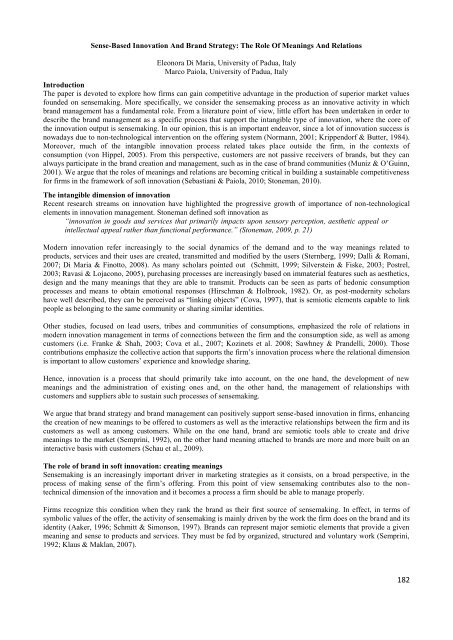Brand, Identity and Reputation: Exploring, Creating New Realities ...
Brand, Identity and Reputation: Exploring, Creating New Realities ...
Brand, Identity and Reputation: Exploring, Creating New Realities ...
Create successful ePaper yourself
Turn your PDF publications into a flip-book with our unique Google optimized e-Paper software.
Sense-Based Innovation And <strong>Br<strong>and</strong></strong> Strategy: The Role Of Meanings And Relations<br />
Eleonora Di Maria, University of Padua, Italy<br />
Marco Paiola, University of Padua, Italy<br />
Introduction<br />
The paper is devoted to explore how firms can gain competitive advantage in the production of superior market values<br />
founded on sensemaking. More specifically, we consider the sensemaking process as an innovative activity in which<br />
br<strong>and</strong> management has a fundamental role. From a literature point of view, little effort has been undertaken in order to<br />
describe the br<strong>and</strong> management as a specific process that support the intangible type of innovation, where the core of<br />
the innovation output is sensemaking. In our opinion, this is an important endeavor, since a lot of innovation success is<br />
nowadays due to non-technological intervention on the offering system (Normann, 2001; Krippendorf & Butter, 1984).<br />
Moreover, much of the intangible innovation process related takes place outside the firm, in the contexts of<br />
consumption (von Hippel, 2005). From this perspective, customers are not passive receivers of br<strong>and</strong>s, but they can<br />
always participate in the br<strong>and</strong> creation <strong>and</strong> management, such as in the case of br<strong>and</strong> communities (Muniz & O‘Guinn,<br />
2001). We argue that the roles of meanings <strong>and</strong> relations are becoming critical in building a sustainable competitiveness<br />
for firms in the framework of soft innovation (Sebastiani & Paiola, 2010; Stoneman, 2010).<br />
The intangible dimension of innovation<br />
Recent research streams on innovation have highlighted the progressive growth of importance of non-technological<br />
elements in innovation management. Stoneman defined soft innovation as<br />
―innovation in goods <strong>and</strong> services that primarily impacts upon sensory perception, aesthetic appeal or<br />
intellectual appeal rather than functional performance.‖ (Stoneman, 2009, p. 21)<br />
Modern innovation refer increasingly to the social dynamics of the dem<strong>and</strong> <strong>and</strong> to the way meanings related to<br />
products, services <strong>and</strong> their uses are created, transmitted <strong>and</strong> modified by the users (Sternberg, 1999; Dalli & Romani,<br />
2007; Di Maria & Finotto, 2008). As many scholars pointed out (Schmitt, 1999; Silverstein & Fiske, 2003; Postrel,<br />
2003; Ravasi & Lojacono, 2005), purchasing processes are increasingly based on immaterial features such as aesthetics,<br />
design <strong>and</strong> the many meanings that they are able to transmit. Products can be seen as parts of hedonic consumption<br />
processes <strong>and</strong> means to obtain emotional responses (Hirschman & Holbrook, 1982). Or, as post-modernity scholars<br />
have well described, they can be perceived as ―linking objects‖ (Cova, 1997), that is semiotic elements capable to link<br />
people as belonging to the same community or sharing similar identities.<br />
Other studies, focused on lead users, tribes <strong>and</strong> communities of consumptions, emphasized the role of relations in<br />
modern innovation management in terms of connections between the firm <strong>and</strong> the consumption side, as well as among<br />
customers (i.e. Franke & Shah, 2003; Cova et al., 2007; Kozinets et al. 2008; Sawhney & Pr<strong>and</strong>elli, 2000). Those<br />
contributions emphasize the collective action that supports the firm‘s innovation process where the relational dimension<br />
is important to allow customers‘ experience <strong>and</strong> knowledge sharing.<br />
Hence, innovation is a process that should primarily take into account, on the one h<strong>and</strong>, the development of new<br />
meanings <strong>and</strong> the administration of existing ones <strong>and</strong>, on the other h<strong>and</strong>, the management of relationships with<br />
customers <strong>and</strong> suppliers able to sustain such processes of sensemaking.<br />
We argue that br<strong>and</strong> strategy <strong>and</strong> br<strong>and</strong> management can positively support sense-based innovation in firms, enhancing<br />
the creation of new meanings to be offered to customers as well as the interactive relationships between the firm <strong>and</strong> its<br />
customers as well as among customers. While on the one h<strong>and</strong>, br<strong>and</strong> are semiotic tools able to create <strong>and</strong> drive<br />
meanings to the market (Semprini, 1992), on the other h<strong>and</strong> meaning attached to br<strong>and</strong>s are more <strong>and</strong> more built on an<br />
interactive basis with customers (Schau et al., 2009).<br />
The role of br<strong>and</strong> in soft innovation: creating meanings<br />
Sensemaking is an increasingly important driver in marketing strategies as it consists, on a broad perspective, in the<br />
process of making sense of the firm‘s offering. From this point of view sensemaking contributes also to the nontechnical<br />
dimension of the innovation <strong>and</strong> it becomes a process a firm should be able to manage properly.<br />
Firms recognize this condition when they rank the br<strong>and</strong> as their first source of sensemaking. In effect, in terms of<br />
symbolic values of the offer, the activity of sensemaking is mainly driven by the work the firm does on the br<strong>and</strong> <strong>and</strong> its<br />
identity (Aaker, 1996; Schmitt & Simonson, 1997). <strong>Br<strong>and</strong></strong>s can represent major semiotic elements that provide a given<br />
meaning <strong>and</strong> sense to products <strong>and</strong> services. They must be fed by organized, structured <strong>and</strong> voluntary work (Semprini,<br />
1992; Klaus & Maklan, 2007).<br />
182
















